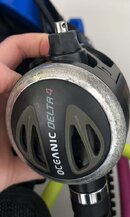lagomorpheus
Registered
- Messages
- 27
- Reaction score
- 3
Inhalation valve lost 15 hours before liveaboard (Oceanic Delta 4)
I am far away from home and due to get on a liveaboard tomorrow morning. On todays morning dive I noticed water entering my reg, particularly on sharp inhalation. Surfaced to find the inhalation valve missing. Regs have been serviced recently.
A potential spare part has been located, and I am aware that servicing my own gear comes with risk. However, this looks to be attachable with the corresponding screw in a straightforward manner.
Can anyone give me insight on whether this missing part is in fact responsible for the water inflow and if this attemptable with an Allen key and a bit of common sense?
Thanks very much in advance for your knowledge
I am far away from home and due to get on a liveaboard tomorrow morning. On todays morning dive I noticed water entering my reg, particularly on sharp inhalation. Surfaced to find the inhalation valve missing. Regs have been serviced recently.
A potential spare part has been located, and I am aware that servicing my own gear comes with risk. However, this looks to be attachable with the corresponding screw in a straightforward manner.
Can anyone give me insight on whether this missing part is in fact responsible for the water inflow and if this attemptable with an Allen key and a bit of common sense?
Thanks very much in advance for your knowledge




